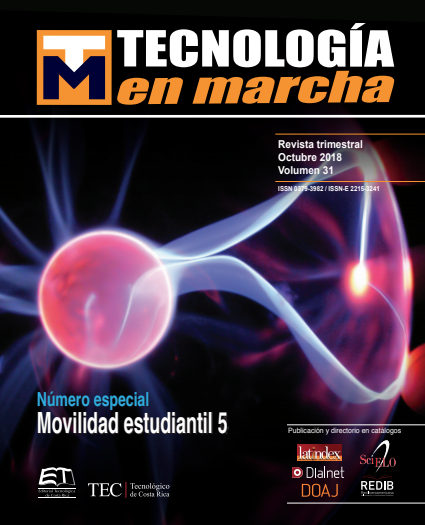Desarrollo de una herramienta de modelado en alta resolución para simular la demanda energética y la producción de energía fotovoltaica in situ: Aplicaciones en Costa Rica
Main Article Content
Abstract
Strategies towards more energy-efficient systems imply the integration and application of urban
energy analysis tools in order to support the sustainable energy systems. Energy systems such
as intermittent solar power, requires research into the comprehensive analysis of the matching
capability between the demand and the production. In order to perform the energy matching
analysis, the aim must involve minimal source of error therefore, more accurate results can be
obtained.
In certain applications of energy simulation, the commonly used time step is one hour,
nevertheless studies have shown that this can be a significant source of error. For the
identification of the impact that time-step have in simulations, holistic models in high resolution were created. With the models, using time a time step of 1 minute, more precise and accurate
results could be obtained.
The generated PV on-site production model is based on a model developed by the research
group Energy Efficient and Smart Cities (EESC). Relevant data needed for the model, such as
irradiance and incident global radiation; was obtained using the software Meteonorm. For the
high-resolution model of domestic electricity demand, the model developed by the Centre for
Renewable Energy Systems Technology of Loughborough University, was used and modified
using relevant information from Costa Rica.
This model implicates PV modules on-site production and adequately represents the domestic
electricity demand. Hence analyses of energy matching capability calculations, such as the
on-site energy fraction index (OEF) which asses how much demand can be covered by the
on-site energy generation and the on-site energy matching index (OEM) which indicates how
much on-site generation can be consumed in the system rather than being exported or wasted;
showed that the usage of coarser resolutions leads to overestimated this capability, and the
same time the error percentage is bigger.
Article Details
Los autores conservan los derechos de autor y ceden a la revista el derecho de la primera publicación y pueda editarlo, reproducirlo, distribuirlo, exhibirlo y comunicarlo en el país y en el extranjero mediante medios impresos y electrónicos. Asimismo, asumen el compromiso sobre cualquier litigio o reclamación relacionada con derechos de propiedad intelectual, exonerando de responsabilidad a la Editorial Tecnológica de Costa Rica. Además, se establece que los autores pueden realizar otros acuerdos contractuales independientes y adicionales para la distribución no exclusiva de la versión del artículo publicado en esta revista (p. ej., incluirlo en un repositorio institucional o publicarlo en un libro) siempre que indiquen claramente que el trabajo se publicó por primera vez en esta revista.

